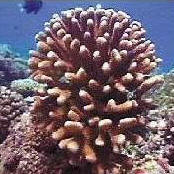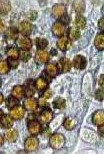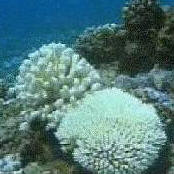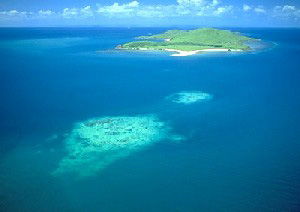 Click To Return To Main Page |
 |
||||||||
 News |
 Eco-Journalists |
 Articles |
 Games |
 Links |
 Facts 'n Fun |
 Email Us |
 About Us |
 Guestbook |
|
|
Coral Bleaching
Healthy coral
 Coral may look like a weird underwater plant, but it is actually a living animal. There are many types of coral. Some are shaped like a big tree, growing at about 10cm per year. Others are mound-shaped and grow at a slow rate of about 1cm per year. Coral grows in warm tropical waters. and generally grows to a depth of 25 metres below the surface. Most corals live in ocean temperatures of around 21 to 23 degrees celsius.
Coral may look like a weird underwater plant, but it is actually a living animal. There are many types of coral. Some are shaped like a big tree, growing at about 10cm per year. Others are mound-shaped and grow at a slow rate of about 1cm per year. Coral grows in warm tropical waters. and generally grows to a depth of 25 metres below the surface. Most corals live in ocean temperatures of around 21 to 23 degrees celsius.
Whilst air temperatures can change quite a bit depending on the season or the weather, ocean temperatures don't change much at all. In fact there is normally only about 4°C difference in the temperature of the water over the whole year. But, if the water temperature rises above that by even just 3°C, a process called coral bleaching can occur. The algae which
lives in the coral  The way that coral gets its energy (food) is very interesting. It has a symbiotic relationship (each gives something to the other and gets something back in return - you scratch my back, I'll scratch yours) with a type of algae which it lets live on it. This means that instead of living on the sea floor, the algae gets to live up on the coral which is closer to the ocean surface and so the algae gets lots of light. It is this sunlight that the algae needs to make its energy through a process called 'photosynthesis'.
The way that coral gets its energy (food) is very interesting. It has a symbiotic relationship (each gives something to the other and gets something back in return - you scratch my back, I'll scratch yours) with a type of algae which it lets live on it. This means that instead of living on the sea floor, the algae gets to live up on the coral which is closer to the ocean surface and so the algae gets lots of light. It is this sunlight that the algae needs to make its energy through a process called 'photosynthesis'.
Photosynthesis is used by most plants to make energy from the sun. The light shines onto the plant or tree. Inside the plant is a substance called chlorophyll (which gives plants their green colour). This chlorophyll helps the plant absorb the sunlight to turn it into energy for the plant just like our bodies turn a hamburger and chips into energy for us to use. Bleached coral after the algae
has been affected  Some of this energy is kept by the algae and some is given to the coral. This is the 'payment' for allowing the algae to live up on the coral. But, when the water becomes too warm, the algae is ejected by the coral out into the ocean. When the algae dies, it turns white. Hence the term "Coral Bleaching". This is happening to all the coral reefs around the world.
Some of this energy is kept by the algae and some is given to the coral. This is the 'payment' for allowing the algae to live up on the coral. But, when the water becomes too warm, the algae is ejected by the coral out into the ocean. When the algae dies, it turns white. Hence the term "Coral Bleaching". This is happening to all the coral reefs around the world.
This is a major problem. Not just for tourism industries who offer tours and diving holidays to see the beautiful reefs, but what we should be more concerned about is that many types of aquatic life need coral reefs to survive. Coral reefs offer many things for fish and other species. The coral provides a place for smaller fish to hide from theirpredators. Some fish will eat the hard coral which is why they have very strong jawbones. Some fish get their food from the coral itself, which is why they have strong jaw-bones to break up the hard food. An area of the Great Barrier Reef which has been bleached
 It can even provide the young fish somewhere to hide in while their parents are out looking for food. Talk about multi-tasking!
It can even provide the young fish somewhere to hide in while their parents are out looking for food. Talk about multi-tasking!
At the rate this is happening, some scientists believe that by 2050, Australia's Great Barrier Reef will have lost up to 95% of its body due to coral bleaching. We have already seen something similar happen in the Carribean. There is only 20% left of what there was 50 years ago. Many scientists believe that the Earth and its oceans are getting hotter because of global warming. The average temperature of the Earth is rising. This is producing a world-wide climate change. Large-scale effects of this include; - changes in rainfall paterns, particularly drought - rising ocean levels caused by polar areas melting - increased storm activity - tornadoes, cyclones etc (hotter weather and more moist weather patterns in some parts) These changes are having great impacts on our flora (plants) and fauna (animal) wildlife. Scientists believe this is all because of human activity and the burning of fossil fuels (coal) to produce electricity. What can we do to stop this? We can turn this problem around, but it will take each individual to make a real effort to change the amount of fossil fuels that they cause to be burnt. You can do this by not making unnescessary car trips, not using heating or airconditioning as much, and turning off electrical appliances when they are not being used (such as lights, computers etc). There are some things that be done to directly help coral reefs: - Permanant poles can be placed at reef areas for ships to tie themselves to instead of dropping an anchor which tears up the coral. - Always refuse to buy jewellery that has been made from coral. - When visiting the reef, view it from a glass bottomed boat, but don't walk on it. - Don't snap off bits of coral for souvenirs. By Alastair Wadlow
A big 'thank you' to the Great Barrier Reef Marine Park Authority for the use of the fantastic photos.
You can learn lots more about coral bleaching at their website at: www.reefed.edu.au/explorer/bleaching/ Information sourced from: http://www.epa.gov/globalwarming/kids/gw.html http://www.elenas-vieques.com/coral.html http://www.newscientist.com/article.ns?id=dn4707 http://www.newscientist.com/article.ns?id=dn3606 |